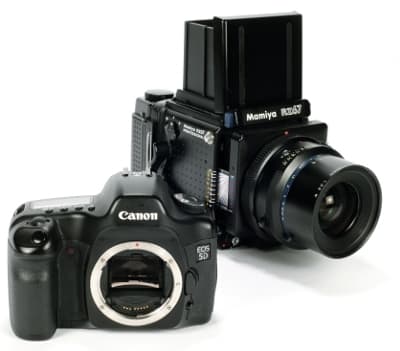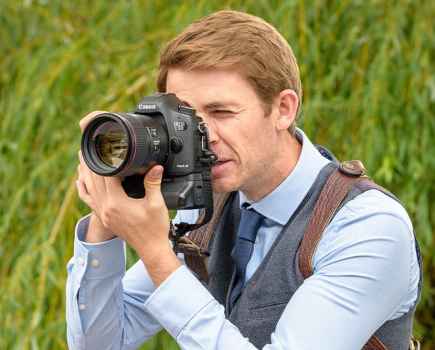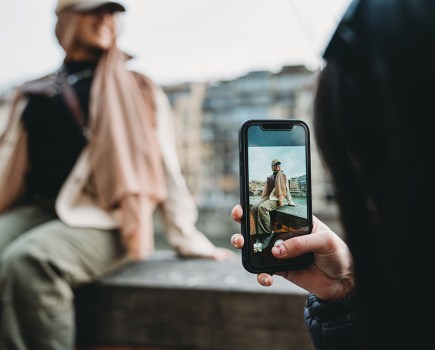Second-hand equipment can be a great bargain.
However, how do you know that the camera you’re looking at has been well-treated by its previous owner?
Our guide to choosing second hand SLR and medium-format cameras suggests a few things to look out for…
Choosing second hand SLR Cameras
Second hand SLR – LCD screen/film compartment
On a film SLR, open the film compartment and check that it is reasonably dust-free and that there are no scratches in the film transport path. Also, check the film pressure plate and make sure it is free from abrasions.
On a digital SLR, make sure you put a battery in the camera, and check that the LCD screen works properly and is evenly illuminated.
Second hand SLR – Viewfinder
Take a good look through the viewfinder of the camera, with batteries installed. Some Nikon DSLRs, like the D200 (see top ten second hand cameras article), have LCD layers in their focusing screens that require power in order to operate. The viewfinders of these cameras are dull and impossible to focus when a battery is not installed.
Also, check for scratches or marks on the focusing screen
Second hand SLR – Hotshoe
Check that the hotshoe doesn’t show signs of excessive wear from frequent mounting of a flashgun.
If the camera has a painted hotshoe it is easy to check that the paint hasn’t been worn away.
Second hand SLR – Status LCD
Although they have proved themselves much more durable than many manufacturers initially thought, the monochrome LCD status screens on SLR cameras don’t last forever.
If you’re considering a camera that is more than five or six years old, check that
the LCD screen is sharp and contrasty with no ‘bleed’ of the liquid crystal, and that there are no dark or light patches in the corners.
Second hand SLR – Lens contacts
Modern SLR cameras have electronic contacts that carry information between the camera body and the lens. Check that these contacts (which are normally golden in colour) do not show signs of excessive wear or dirt build-up.
While you’re in there, check that the camera’s mirrorbox is clean and free of dirt, and that the mirror is unmarked. Although a scratched mirror won’t affect image quality, it could be a sign that the camera has been misused and that other, hidden, problems exist.
Choosing second hand medium format cameras
Second hand medium format camera – Film holder
The film holder or camera back contains the film and determines the format of the image. With a modular camera system the back can be preloaded. Professional photographers may have several backs loaded so they can swap them quickly and continue the shoot.
Having an extra back or two also enables a mid-roll change of film, perhaps switching from colour to black & white, negative to transparency.
Polaroid backs were popular with pros as they enabled test images to be taken
and checked quickly. Unfortunately, most compatible film is no longer made, largely because of the switch to digital backs that allow medium-format digital capture.
Second hand medium format camera – Finder
Some cameras can accept a choice of viewfinder. The basic option for many is the waist-level finder, which has a ground-glass screen that is viewed from above when the camera is held at approximately waist-height.
Most waist-level finders have a pop-up magnifying screen, which enables focus to be checked more closely. The image in the viewfinder is laterally reversed so left and right are swapped. This can cause some confusion when composing images for the first time, but it is surprising how quickly you get used to it.
Waist-level finders can often be exchanged for compatible prism finders, some of which have built-in lightmeters. A prism viewfinder is held to the eye and gives a correctly orientated view of the world.
Second hand medium format camera – Metering
Many medium-format cameras don’t have a lightmeter built-in, so a handheld device or a second camera with a lightmeter is a useful accompaniment on any shoot.
Second hand medium format camera – Body
At its simplest, the camera body is a light-tight box with a mirror that accepts a viewfinder, camera back (or film holder) and lens. However, the size of the body dictates the maximum format size.
This is usually quoted as 6×4.5cm, 6x6cm, 6x7cm, and so on. Bear in mind, though, that the actual picture size is a fraction under the format size, so a 6x7cm camera may actually produce an image nearer to 5.6×6.95cm.
Related content:
- For more information on second hand dealers see our second hand dealer listings
- For information on picking up a second hand camera at a camera fair see our article on camera fairs







